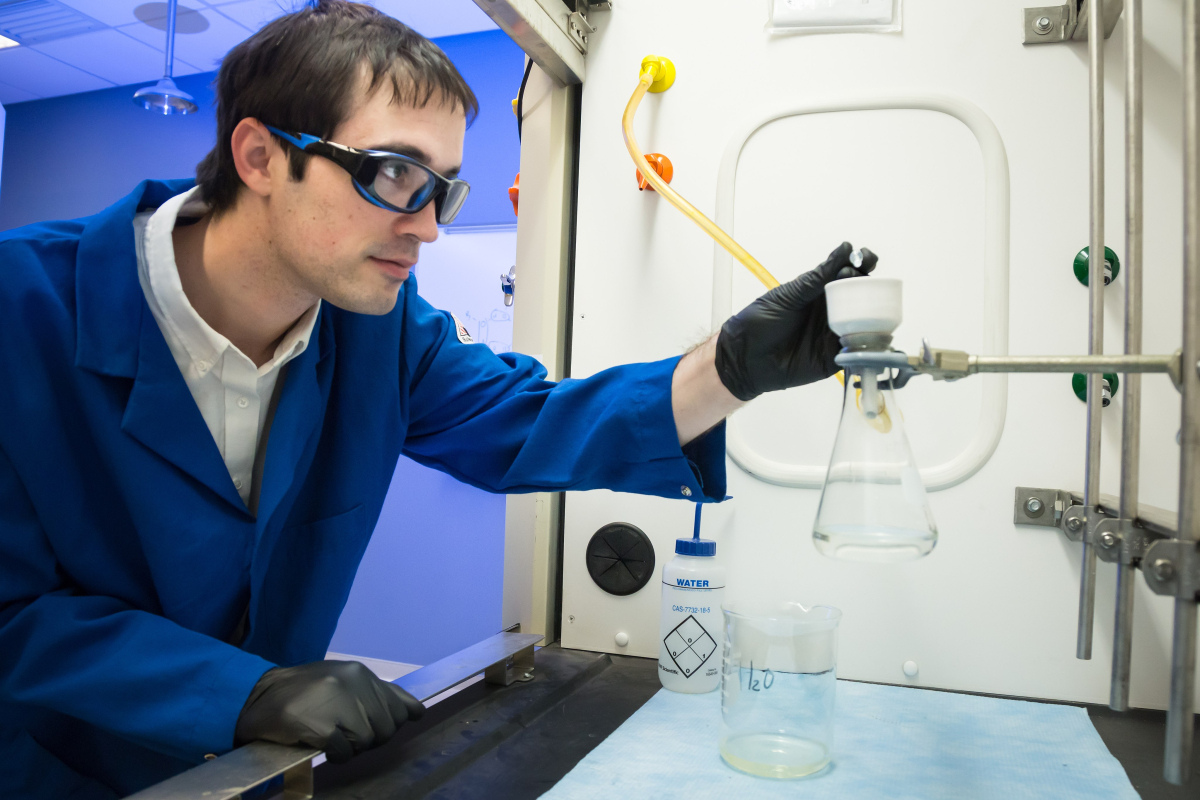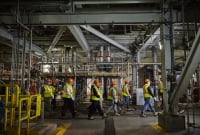Support strong Canadian climate journalism for 2025
A single tax incentive under consideration in Ottawa has the potential to create jobs, grow businesses and investment, and cut Canada’s carbon emissions. It’s called the investment tax credit for carbon capture, utilization, and storage.
Dozens of Canadian companies, not-for-profit associations, unions, provincial governments, Indigenous groups, environmental NGOs and think tanks have asked for it. The federal government has committed to introducing it this year.
Then last week, a group of Canadian academics decided to publicly oppose the new tax credit in an open letter to the federal finance minister. Late to the game, this letter really misses the mark. Here’s why.
Technologies to trap industrial carbon emissions and store them deep underground, to suck CO2 directly out of the atmosphere and inject it into building products like cement, are proven and viable. We have been sequestering carbon dioxide below ground safely and effectively since the 1970s.
Our challenge is that almost all carbon capture projects are uneconomic when their only incentive is today’s carbon price. On that point, we and the signatories agree.
But that’s about where agreement ends.
The academics argue that carbon capture has a “limited potential to deliver … emissions reductions” and is not needed to reach Canada’s climate targets. This runs contrary to the conclusions of experts like the International Energy Agency (IEA), the National Academies of Sciences, Engineering, and Medicine and the Intergovernmental Panel on Climate Change (IPCC).
A recent report from the IPCC, the pre-eminent group of global climate scientists, showed that every scenario that keeps the planet from exceeding 1.5 C of warming will require large-scale removal of carbon from the atmosphere.
Rejecting carbon capture technology won’t reduce emissions the way these dissenting academics hope — in fact, it’s likely to increase them. Consider the cement industry, for example, which produces eight per cent of global greenhouse gas output. A significant share of that CO2 comes from unavoidable chemical reactions, rather than the burning of fossil fuels. The only viable solution available today is to capture those emissions.
Moreover, how do we stay within safe levels of warming without capturing carbon dioxide from the air? Even if we meet the global goal of net-zero by 2050, we will need to remove billions of tonnes of CO2 from our atmosphere this century using technologies like direct air capture. Cancelling the investment tax credit will make it much more difficult to start building out that industry.
Put simply: Canada and the world need carbon capture in the toolkit to address climate change and meet international climate obligations.
But it’s not just the climate impact that the academics overlook. They also seem to misunderstand the state of play in the carbon capture industry. Their letter states that carbon capture is not “proven at scale” and is not “economically sound.” But there are more than 36 million tonnes of CO2 being captured around the world annually from a variety of industries and sources, including projects capturing carbon at a cost well below $50 per tonne. Early small-scale direct air capture projects are now operating, too, and bigger projects are in the works.
Further deployment has been limited not by fundamental technical problems, but by a lack of policy support and potential revenue sources. The investment tax credit for carbon capture, combined with Canada’s carbon pricing system and high-integrity regulation, can grow the industry. This will, in turn, create jobs, cut emissions, and reduce technology costs. Let’s remember it took solar energy decades of public support to become inexpensive and broadly deployed.
Other countries are already investing aggressively in carbon capture. Look south of the border, where a mix of regulations and incentives are stimulating the investment needed to get carbon capture going, with more than 25 commercial-scale carbon capture projects in development.
Canada needs to replicate this success, and already has most of the right ingredients: a carbon pricing system, an active research and innovation ecosystem, suitable geology for permanent carbon storage, and a skilled workforce that can engineer, build, and run carbon capture projects.
What’s missing are the right policy incentives. Canada’s carbon credit market is still in its infancy, so most investors are wary of lending to projects that rely on it for future revenues. By complementing the carbon price and regulations like the Clean Fuel Standard with an investment tax credit, government can lower the risk and make projects more attractive to private capital. That's what we need to get this industry off the ground.
If we’re serious about reducing our emissions — and growing Canada’s cleantech sector — we are going to need all the tools in our toolkit, including carbon capture. That’s why we need a carbon capture tax credit, and a supportive ecosystem — including academia — to help us put it to work.
Ed Whittingham is a clean energy policy consultant and co-host of the Energy vs Climate podcast.
Michael Bernstein is executive director of Clean Prosperity.







Comments
I was depressed all day after rejecting a petition request against carbon capture. Sure, the oil companies have abused the process, but that does not prove it can't be done right. We have dithered so long that we are into positive feedback with arctic methane, and MUST go carbon-negative. Just requiring the permanent sequestration of more recovered carbon than will be released as a condition of sale for fuels would drive innovation the right way.
The problem is that CCS is only very rarely being advanced as a solution. Rather, it is being advanced as at best an excuse, a way of tinkering with the problem rather than dealing with it. The hypotheticals of what might be done with CCS if you could somehow get people to use it "the right way" run smack into the reality that it's not a technology developed to do those things, it's a technology developed almost entirely for the purpose of running scams.
People talking about how we should be practical and find ways of using CCS for good rather than evil sound to me basically like people saying the same thing about Ponzi schemes. Which is to say, very naive.
Bernstein & Wittingham have obviously not read the letter presented by the petitioning scientists. The letter is quite specific in their objects, which are that they are not against Carbon Capture & Sequestering (CCS) specifically, but just the current technology which they believe does not warrant a credit. In particular they are opposed to giving a credit for CCS that uses a technique called Enhanced Oil Recovery, which is the only existing commercially available technology. This technique increases the amount of fossil fuel being taken out of the ground at a time when we need to be leaving crude oil in the ground. Further, the letter states a number of limitations under which CCS, in their opinion, could earn a carbon credit. So, they are clearly no against CCS, just bad CCS and even suggest the specific ways in which the government could tighten up its legislation to make a credit available to CCS. Since the above commentators obviously chose not to read the letter, or perhaps to ignore it, I've included a direct link to the petitioning scientist's letter here, so readers can see for themselves what the scientists actually said.
https://cehoicka.lab.yorku.ca/files/2022/01/Letter-from-Academics-re-CC…
The letter is worth quoting here. The signatories clearly do not support CCS, especially in the context of the oil & gas industry, and especially not in the context of enhanced oil recovery (EOR). The sole exception is for "sectors for which there are no decarbonization options":
-------------------
"Effective solutions to achieve deep emission reductions in the next decade along a pathway to zero emissions are already at hand, including renewable energy, electrification and energy efficiency. Funding CCUS diverts resources from these proven, more cost effective solutions that are available on the timeframes required to mitigate climate change.
"Despite decades of research, CCUS is neither economically sound nor proven at scale, with a terrible track record and limited potential to deliver significant, cost-effective emissions reductions.
"…Moreover, CCUS remains prohibitively expensive, while the costs of renewables have plummeted to the point that they are cheaper than fossil fuels.4 So unsurprisingly, over 80% of CCUS projects in the United States have failed.
"Carbon capture for the oil and gas sector is not a climate solution. At best, it prevents some carbon dioxide from polluting facilities from reaching the atmosphere, but it is not a negative emissions technology. Despite the billions of taxpayer dollars spent by governments globally on CCUS, the technology has not made a dent in CO2 emissions. Nor is it anticipated to expand to the scale needed: for this reason, the Intergovernmental Panel on Climate Change (IPCC) points to uncertainty in the future deployment of CCUS and cautions against reliance on the technology.
"…Carbon capture methods are being used to boost oil production, and have therefore resulted in increased emissions.
"… Put simply, rather than replacing fossil fuels, carbon capture prolongs our dependence on them at a time when preventing catastrophic climate change requires winding down fossil fuel use. Relying on CCUS preserves status quo fossil fuel development, which must be curtailed to meet global climate commitments. Introducing a tax credit for CCUS for the energy sector will lock-in continued dependence on Canada’s largest and most rapidly growing source of greenhouse gas emissions.
"…Enhanced oil recovery projects should not be eligible for the tax credit. Only ‘permanent’ storage projects should be considered. The tax credit should only be made available for sectors for which there are no decarbonization options. Oil and gas projects, including fossil or blue hydrogen, as well as plastics and petrochemical production, should not be eligible for the credit.
"… The biggest beneficiaries of the American tax credit are oil companies. Analysis done on the 45Q tax credit found it could result in at least an additional 400,000 barrels per day of CO2-enhanced oil production in the United States by 2035.
"… Deploying CCUS at any climate-relevant scale, carried out within the short timeframe we have to avert climate catastrophe without posing substantial risks to communities on the frontlines of the buildout, is a pipe dream."
Throwing billions of dollars in subsidies at hugely profitable oilsands companies to cut emissions boosts shareholder profits, too. Great idea!
Under this scheme, taxpayers will relieve multi-billion dollar, largely foreign-owned oilsands companies of their obligations for emissions reduction, pollution mitigation, clean-up, and reclamation. Reducing company costs boosts profits. Great news for shareholders. Taxpayers, not so much.
So much for polluter pay.
Privatize the profits, socialize the costs. The fossil fuel industry's business model.
*
As Whittingham fails to note, there are far more cost-effective solutions available. Cheaper ways to cut more emissions. CCS is highly energy-intensive as well as expensive. Huge opportunity costs. Invest the same scarce resources in public transit, energy efficiency and conservation, building retrofits, smart urban design, and renewables, and we can cut far more emissions.
CCS should be reserved for hard-to-decarbonize processes like steel and cement. Used to extend fossil fuels' lifetime, more emissions will result, not less.
*
Net-zero upstream emissions targets are greenwashing. Capturing upstream operations does nothing to reduce the 80–90% of emissions from a barrel of downstream at the consumer end. CCS does not capture other pollutants.
Far cheaper not to put those emissions into the atmosphere in the first place.
No way should taxpayers be on the hook to reduce emissions from massively profitable companies. If CCS is effective and viable, let industry pay for it.
P.S. Please name the environmental NGOs that support CCS. Also list the ENGOs opposing it. What's the score?
"But there are more than 36 million tonnes of CO2 being captured around the world annually from a variety of industries and sources"
Whittingham fails to put this figure in context. Global emissions are 1000 times higher. CCS currently captures 0.1% of global emissions at high cost. On the order of emissions from Manitoba, Nova Scotia, and New Brunswick.
*
Energy ecologist Vaclav Smil: "Mark my words, there’ll be no massive sequestration of carbon. There hasn’t been any, and there’ll not be any next year, or 2025, or 2030.
"…The scale. We now make about 37 billion tons of CO2. 10% of that is 3.7 billion tons. Say 4 billion tons of C02, just to control 10% of the problem. This is almost exactly the amount of crude oil we produce. It took us 100-plus years to develop an industry, which is taking 4 billion tons out of the ground and with the gradient, and then taking it up and refining and using it. Now we would have to develop a new industry, which would take 4 billion tons, and store it, push it against the gradient into the ground, and guarantee that it will stay there forever. Something like this cannot be done in 5, or 10, or 15 years. And this is 10%. So, simply on the matter of scale, carbon sequestration is just simply dead on arrival."
"Vaclav Smil: We Must Leave Growth Behind" (Intelligencer – New York Magazine)
https://nymag.com/intelligencer/2019/09/vaclav-smil-on-the-need-to-aban…
*
Carbon removal from the atmosphere is an even more daunting and expensive proposition than carbon capture from concentrated industrial waste streams. Because 410+ ppm CO2 is much more dilute, the challenge to remove CO2 from the atmosphere is much harder and more energy intensive.
Audrey Mascarenhas, president and chief executive of Questor Technology, a company that aims to eliminate methane emissions from flaring: "So in Canada, because we focused [our efforts] on CO2, and we spent a lot of time trying to figure out how we can remove CO2 and turn it into something useful or sequester it. That is expensive, because CO2 in the atmosphere has kind of reached its maximum state of randomness or entropy. So when you try and take it out of the atmosphere it’s like trying to reverse gravity, you’re going to take energy to do it. So if you approach climate change from just the CO2 part, you’re doing the toughest thing first and yes, it is expensive."
Why stop using fossil fuels if we can just suck emissions out of the atmosphere later? That's what the fossil fuel industry will argue. CCS is an excuse to keep burning fossil fuels. A plan to "green" fossil fuels, not get off them.
Carbon capture used to reduce upstream O&G emissions perpetuates fossil fuels. CCS means fossil fuels for longer. More emissions, not less. CCS keeps us dependent on fossil fuels — not a transformative solution.
What does the IEA say? Its "Net Zero by 2050" Roadmap prescribes "no investment in new fossil fuel supply projects" after last year. The O&G industry has other ideas.
*
"Current net zero policies will not keep warming to within 1.5°C because they were never intended to. They were and still are driven by a need to protect business as usual, not the climate. If we want to keep people safe then large and sustained cuts to carbon emissions need to happen now. That is the very simple acid test that must be applied to all climate policies. The time for wishful thinking is over."
"Climate scientists: concept of net zero is a dangerous trap" (The Conversation, April 22, 2021)
https://theconversation.com/climate-scientists-concept-of-net-zero-is-a…
*
An ounce of prevention…
Our first priority right now should be limiting emissions. The less emissions now, the less future generations will have to remove at high cost later, and the less climate impact overall.
Not for the first time, Whittingham finds himself on the pro-industry, anti-environmental, anti-climate side of the argument.
The former Pembina director and longtime industry collaborator loudly supported the Trans Mtn expansion project. He wrote an op-ed boosting the project in the Globe & Mail with talking points lifted straight from CAPP:
"Mine may be a minority view within the environmental community, but I support the federal govt's approval of twinning the existing TM Pipeline. It is the right decision for Alberta and Canada."
"Balancing climate and energy policy, the Trans Mountain pipeline is the right decision for Canada"
• https://www.theglobeandmail.com/opinion/article-balancing-climate-and-e…
Unfortunately, "balancing climate and energy policy" means the climate loses, so we all lose, even the energy industry. No consumers on a dead planet.
*
Under Whittingham, Pembina promoted oxymoronic "responsible" oilsands development.
The Pembina Institute is largely funded by oil & gas companies, and the Big Banks that back them. Pembina is "the green group that the oilpatch can work with". (Financial Post, April 21, 2016)
• business.financialpost.com/commodities/energy/meet-the-only-green-group-the-oilpatch-can-stand/wcm/5ba292f3-3b39-4849-a52e-d496302a308f
Pembina's "smart climate policies" do not lead to our inadequate Paris targets. They lead us over the climate cliff.
Removing CO2 is not so expensive if you incentivise folks to use photosynthesis to do the removal, although keeping that carbon captured if it is in organic material is a challenge.
These authors make misleading claims of support for CCS from the National Academies of Sciences, Engineering, and Medicine, and from the IPCC. The IPCC reference has little good to say in its passing comment about what they call Carbon Dioxide Removal (CDR), under which they also include afforestation. I don't see anywhere in their report anything that supports the interpretation by the authors of this article that "every scenario that keeps the planet from exceeding 1.5 C of warming will require large-scale removal of carbon from the atmosphere."
What it does say in summary is:
"The faster reduction of net CO2 emissions in 1.5°C compared to 2°C pathways is predominantly achieved by measures that result in less CO2 being produced and emitted, and only to a smaller degree through additional CDR. Limitations on the speed, scale and societal acceptability of CDR deployment also limit the conceivable extent of temperature overshoot. Limits to our understanding of how the carbon cycle responds to net negative emissions increase the uncertainty about the effectiveness of CDR to decline temperatures after a peak.
"CDR deployed at scale is unproven, and reliance on such technology is a major risk in the ability to limit warming to 1.5°C."
Most of the other references in this NO article are from vested industry sources.
Climate Council paper on CCS:
"Key points:
* Carbon capture and storage (otherwise known as CCS) is a licence to ramp up emissions.
* CCS will never be a ‘zero-emissions’ solution.
* CCS is eye-wateringly expensive.
* Chevron’s Gorgon Gas Plant in WA, which is the biggest attempt at a CCS project in the world, is a big, expensive failure."
~~~~~~~~~~~~~~~~~~~~~~~~~~~~~~~~~~~
"Every CCS project that has been undertaken so far has resulted in significant delays and massive cost blowouts. Even when they get a project up and running, CCS trial sites like Chevron’s Gorgon gas plant continue to belch out huge amounts of pollution.
"Worldwide, CCS trials on coal-fired power stations have been monumental failures. The few that have got off the ground have grossly exceeded budget and schedule, massively underdelivered on carbon promised to be captured, and are now mostly shuttered. No company is prepared to underwrite a CCS project for the life of storage; which leaves that risk to taxpayers."
~~~~~~~~~~~~~~~~~~~~~~~~~~~~~~~~~~~
"Over the past decade, wind and solar have become cheaper each year and are now the cheapest type of new energy build. Over the same period, CCS has remained extremely expensive. THERE IS NOT A SINGLE CARBON CAPTURE AND STORAGE PROJECT IN THE WORLD THAT HAS DELIVERED ON TIME, ON BUDGET, AND CAPTURED THE AGREED AMOUNT OF CARBON." (my emphasis)
~~~~~~~~~~~~~~~~~~~~~~~~~~~~~~~~~~~
"CCS has not been trialled and tested – anywhere in the world – at the scale required to tackle the climate crisis. When attached to fossil fuel developments – like coal, oil and gas – CCS is not a climate solution, as digging up and burning fossil fuels only adds to the problem."
https://www.climatecouncil.org.au/resources/what-is-carbon-capture-and-…
"Honest Government Ad | Carbon Capture & Storage"
https://www.youtube.com/watch?v=MSZgoFyuHC8&ab_channel=thejuicemedia
Carbon capture (CCS) is an outrageous greenwashing gimmick. It amounts to consuming energy to capture an insignificant amount of CO2 from the atmosphere thus providing more demand for fossil fuels while justifying the fossil fuels we already burn. Paid for by taxpayers, CCS is an oil and gas executive and shareholder's dream. Here's a better way to reduce CO2 emissions - foster development of Canadian green energy technologies and use incentives to make it easier for businesses and homeowners to use them. Meanwhile cut subsidies to the oil and gas industry and force them to clean up their mess.
CCUS is an expensive unproven way to deal with the problem of emissions. Oil & gas companies love the attention CCUS gets since it greenwashes their industry and allows them to continue BAU. The best way is to reduce GHG emissions is to not produce them by using renewable energy and clean cement production techniques. We need to invest public money into replacing fossil fuels not into extending their use.
The article completely skirts the fact that almost all CCUS is used to enhance oil and gas extraction. The federal government's option is quite straightfoward, as the letter clearly stated: "Oil and gas projects, including fossil or blue hydrogen, as well as plastics and petrochemical production, should not be eligible for the credit." Applications in cement and for direct capture (for permanent storage) should be encouraged.